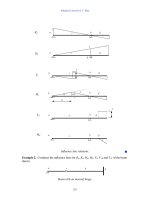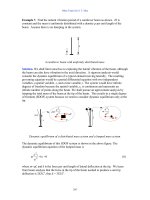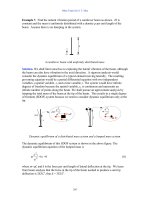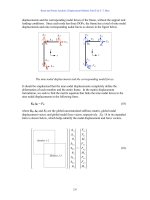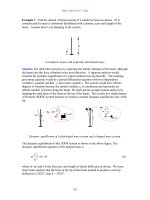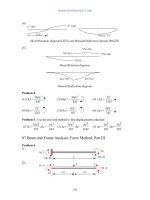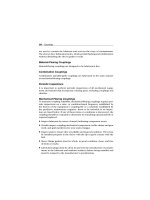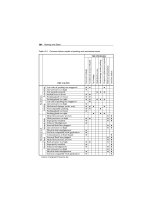(McGraw-Hill) (Instructors Manual) Electric Machinery Fundamentals 4th Edition Episode 2 Part 7 ppt
Bạn đang xem bản rút gọn của tài liệu. Xem và tải ngay bản đầy đủ của tài liệu tại đây (103.04 KB, 3 trang )
DC MOTORS AND GENERATORS 627
9–19. A series motor is now constructed from this machine by leaving the shunt field out
entirely. Derive the torque–speed characteristic of the resulting motor.
9–20. An automatic starter circuit is to be designed for a shunt motor rated at 15 hp, 240
V, and 60 A. The armature resistance of the motor is 0.15 ⍀, and the shunt field re-
sistance is 40 ⍀. The motor is to start with no more than 250 percent of its rated ar-
mature current, and as soon as the current falls to rated value, a starting resistor
stage is to be cut out. How many stages of starting resistance are needed, and how
big should each one be?
9–21. A 15-hp, 230-V, 1800 r/min shunt dc motor has a full-load armature current of 60 A
when operating at rated conditions. The armature resistance of the motor is R
A
ϭ
0.15 ⍀, and the field resistance R
F
is 80 ⍀.The adjustable resistance in the field cir-
cuit R
adj
may be varied over the range from 0 to 200 ⍀ and is currently set to 90 ⍀.
Armature reaction may be ignored in this machine. The magnetization curve for this
motor, taken at a speed of 1800 r/min, is given in tabular form below:
E
A
, V 8.5 150 180 215 226 242
I
F
, A 0.00 0.80 1.00 1.28 1.44 2.88
(a) What is the speed of this motor when it is running at the rated conditions spec-
ified above?
(b) The output power from the motor is 7.5 hp at rated conditions. What is the out-
put torque of the motor?
(c) What are the copper losses and rotational losses in the motor at full load (ignore
stray losses)?
(d) What is the efficiency of the motor at full load?
(e) If the motor is now unloaded with no changes in terminal voltage or R
adj
, what
is the no-load speed of the motor?
(f) Suppose that the motor is running at the no-load conditions described in part e.
What would happen to the motor if its field circuit were to open? Ignoring ar-
mature reaction, what would the final steady-state speed of the motor be under
those conditions?
(g) What range of no-load speeds is possible in this motor, given the range of field
resistance adjustments available with R
adj
?
9–22. The magnetization curve for a separately excited dc generator is shown in Figure
P9–7. The generator is rated at 6 kW, 120 V, 50 A, and 1800 r/min and is shown in
Figure P9–8. Its field circuit is rated at 5A. The following data are known about the
machine:
R
A
ϭ 0.18 ⍀ V
F
ϭ 120 V
R
adj
ϭ 0 to 30 ⍀ R
F
ϭ 24 ⍀
N
F
ϭ 1000 turns per pole
Answer the following questions about this generator, assuming no armature reaction.
(a) If this generator is operating at no load, what is the range of voltage adjustments
that can be achieved by changing R
adj
?
(b) If the field rheostat is allowed to vary from 0 to 30 ⍀ and the generator’s speed
is allowed to vary from 1500 to 2000 r/min, what are the maximum and mini-
mum no-load voltages in the generator?
cha65239_ch09.qxd 11/14/03 10:10 AM Page 627
630 ELECTRIC MACHINERY FUNDAMENTALS
The machine has the magnetization curve shown in Figure P9–7. Its equivalent cir-
cuit is shown in Figure P9–10. Answer the following questions about this machine,
assuming no armature reaction.
(a) If the generator is operating at no load, what is its terminal voltage?
(b) If the generator has an armature current of 20 A, what is its terminal voltage?
(c) If the generator has an armature current of 40 A, what is its terminal voltage?
(d) Calculate and plot the terminal characteristic of this machine.
9–28. If the machine described in Problem 9–27 is reconnected as a differentially com-
pounded dc generator, what will its terminal characteristic look like? Derive it in the
same fashion as in Problem 9–27.
9–29. A cumulatively compounded dc generator is operating properly as a flat-
compounded dc generator. The machine is then shut down, and its shunt field con-
nections are reversed.
(a) If this generator is turned in the same direction as before, will an output voltage
be built up at its terminals? Why or why not?
(b) Will the voltage build up for rotation in the opposite direction? Why or why
not?
(c) For the direction of rotation in which a voltage builds up, will the generator be
cumulatively or differentially compounded?
9–30. A three-phase synchronous machine is mechanically connected to a shunt dc ma-
chine, forming a motor–generator set, as shown in Figure P9–11. The dc machine is
connected to a dc power system supplying a constant 240 V, and the ac machine is
connected to a 480-V, 60-Hz infinite bus.
The dc machine has four poles and is rated at 50 kW and 240 V. It has a per-unit
armature resistance of 0.04. The ac machine has four poles and is Y-connected. It is
rated at 50 kVA, 480 V, and 0.8 PF, and its saturated synchronous reactance is 2.0 ⍀
per phase.
All losses except the dc machine’s armature resistance may be neglected in this
problem. Assume that the magnetization curves of both machines are linear.
(a) Initially, the ac machine is supplying 50 kVA at 0.8 PF lagging to the ac power
system.
R
A
+ R
S
N
se
= 20 turns
E
A
V
T
20
+
–
I
F
I
L
I
A
L
F
N
F
= 1000
turns
R
F
L
S
R
adj
+
–
0.21
FIGURE P9–10
The compounded dc generator in Problems 9–27 and 9–28.
cha65239_ch09.qxd 11/14/03 10:10 AM Page 630
680 ELECTRIC MACHINERY FUNDAMENTALS
(f) P
out
(g)
ind
(h)
load
(i) Efficiency
10–6. Find the induced torque in the motor in Problem 10–5 if it is operating at 5 percent
slip and its terminal voltage is (a) 190 V, (b) 208 V, (c) 230 V.
10–7. What type of motor would you select to perform each of the following jobs? Why?
(a) Vacuum cleaner
(b) Refrigerator
(c) Air conditioner compressor
(d) Air conditioner fan
(e) Variable-speed sewing machine
(f) Clock
(g) Electric drill
10–8. For a particular application, a three-phase stepper motor must be capable of step-
ping in 10° increments. How many poles must it have?
10–9. How many pulses per second must be supplied to the control unit of the motor in
Problem 10–8 to achieve a rotational speed of 600 r/min?
10–10. Construct a table showing step size versus number of poles for three-phase and
four-phase stepper motors.
REFERENCES
1. Fitzgerald, A. E., and C. Kingsley, Jr. Electric Machinery. New York: McGraw-Hill, 1952.
2. National Electrical Manufacturers Association. Motors and Generators, Publication No. MG1-
1993. Washington, D.C.: NEMA, 1993.
3. Veinott, G. C. Fractional and Subfractional Horsepower Electric Motors. New York: McGraw-
Hill, 1970.
4. Werninck, E. H. (ed.). Electric Motor Handbook. London: McGraw-Hill, 1978.
cha65239_ch10.qxd 11/14/03 12:41 PM Page 680

